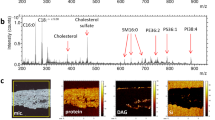Abstract
Purpose. The possibilities of the noninvasive examination of microacidity5 in different depths of the skin in vitro was explored, and the impact of drug treatment on the pH inside the skin was studied.
Methods. Spectral-spatial electron spin resonance imaging (ss-ESRI) and pH-sensitive nitroxides were used to obtain a pH map of rat and human skin in vitro.
Results. The dermal application of therapeutically used acids, such as salicylic acid and azelaic acid, caused a plain change of microacidity (pH) inside the skin. Species-linked differences between rat and human skin samples with respect to penetration and microacidity were found.
Conclusions. ESRI has been shown to be a new and completely noninvasive method to monitor microacidity in different skin layers and on the skin surface. This nondestructive method allows serial measurements on skin samples to be performed without any preparatory steps.
Similar content being viewed by others
REFERENCES
P. Thune, T. Nilsen, I. K. Hanstad, T. Gustavsen, and H. Lovig Dahl. The water barrier function of the skin in relation to the water content of stratum corneum, pH and skin lipids. The effect of alkaline soap and syndet on dry skin in elderly, nonatopic patients. Acta Derm. Venerol. 68:277-283 (1988).
S. Dikstein and A. Zlotogorski. Measurement of skin pH. Acta Derm. Venerol. Suppl. (Stockh.) 185:18-20 (1994).
L. E. Lin, M. Shporer, and M. M. Civan. 31P-nuclear magnetic resonance analysis of perfused single frog skin. Am. J. Physiol. 248:177-180 (1985).
C. J. Deutsch and J. S. Taylor. Intracellular pH as measured by 19F NMR. Ann. NY Acad. Sci. 508:33-47 (1987).
A. Madden, M. O. Leach, J. C. Sharp, D. J. Collins, and D. Easton. A quantitative analysis of in vivo pH measurements with 31P-NMR spectroscopy: Assessment of pH measurement methodology. NMR Biomed. 4:1-11 (1991).
V. V. Khramtsov, D. Marsh, L. Weiner, I. A. Grigoriev, and L. B. Volodarsky. Proton exchange in stable nitroxyl radicals. EPR study of the pH of aqueous solutions. Chem. Phys. Lett. 91:69-72 (1982).
V. V. Khramtsov, D. Marsh, L. Weiner, and V. A. Reznikov. The application of pH-sensitive spin labels to studies of surface potential and polarity of phospholipid membranes and proteins. Biochim. Biophys. Acta 1104:317-324 (1992).
C. Kroll, K. Mäder, R. Stöβer, and H.-H. Borchert. Direct and continuous determination of pH values in nontransparent w/o systems by means of ESR spectroscopy. Eur. J. Pharm. Sci. 3:21-26 (1995).
A. Brunner, K. Mäder, and A. Göpferich. The microenvironment inside biodegradable microspheres: changes in pH and osmotic pressure. Pharm. Res. 16:847-853 (1999).
I. Katzhendler, K. Mäder, and M. Friedman. Correlation between drug release kinetics from proteineous matrix and matrix structure: EPR and NMR study. J. Pharm. Sci. 89:365-381 (2000).
K. Mäder, B. Gallez, K. J. Liu, and H. M. Swartz. Noninvasive in vivo characterization of release processes in biodegradable polymers by low frequency electron paramagnetic resonance spectroscopy. Biomaterials 17:459-463 (1996).
B. Gallez, K. Mäder, and H. M. Swartz. Noninvasive measurement of the pH inside the gut by using pH-sensitive nitroxides. An in vivo EPR study. Magn. Reson. Med. 36:694-697 (1996).
M. M. Maltempo, S. S. Eaton, and G. R. Eaton. Spectra-spatial imaging. In G. R. Eaton, S. S. Eaton and K. Ohno (eds.), EPR Imaging and In Vivo EPR, CRC Press, Boca Raton, FL, 1991 pp. 135-143.
K. Mäder, S. Nitschke, R. Stöβer, H.-H. Borchert, and A. Domb. Nondestructive and localized assessment of acidic microenvironments inside biodegradable polyanhydrides by spectral spatial electron paramagnetic resonance imaging. Polymer 38:4785-4794 (1997).
H. M. Rauen. Biochemisches Taschenbuch, Springer Verlag, Berlin, 1964.
C. Kroll. Analytik, Stabilität und Biotransformation von Spinsonden sowie deren Einsatz im Rahmen pharmazeutisch-technologischer und biopharmazeutischer Untersuchungen. Dissertation, Humboldt-Universität zu Berlin, 1999.
J. Fuchs, H. J. Freisleben, M. Podda, G. Zimmer, R. Milbradt, and L. Packer. Nitroxide radical biostability in skin. Free Radic. Biol. Med. 15:415-423 (1993).
M. Przerwa and M. Arnold. Studies on the penetrability of skin. Arzneimittel-Forschung 25:1048-1053 (1975).
Author information
Authors and Affiliations
Rights and permissions
About this article
Cite this article
Kroll, C., Herrmann, W., Stöβer, R. et al. Influence of Drug Treatment on the Microacidity in Rat and Human Skin—An In Vitro Electron Spin Resonance Imaging Study. Pharm Res 18, 525–530 (2001). https://doi.org/10.1023/A:1011066613621
Issue Date:
DOI: https://doi.org/10.1023/A:1011066613621




